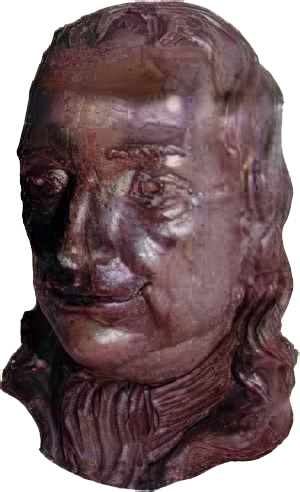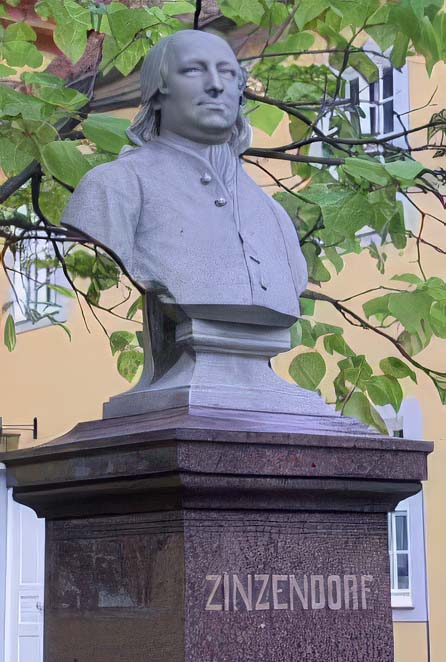What do you do when the Founder of the city is missing, and his birthday is coming up? That was the dilemma which recently confronted officials in Bethlehem, PA — with a happy if mysterious ending.

The story began in 1979 with the dedication of a bronze bust of Count Zinzendorf in part of the historic area. Thirty-five individuals and organizations had donated to commission the bust by sculptor Richard Lieberman. The bust was placed next to the Hotel Bethlehem, built on the site of the First House, a log cabin where the travelling Count had officially named the city-to-be on Christmas Eve, 1741.
A few years ago, the Count had to be moved in order for archaelogists to excavate a historic forge. The bust was placed in storage in the nearby Luckenbach Mill and plans were laid for a “Founder’s Park” in the historic industrial area.
But as the Zinzendorf Jubilee drew near, the location of the bust became a major mystery. In December, 1999 as the Comenius Foundation production crew taped segments for the Zinzendorf documentary in Bethlehem, they asked permission to take pictures of the bust. No one was quite sure where it was. A search of the buildings owned by the Historic Bethlehem ensued, to no avail. The Jubilee was rapidly approaching, the pedestal in the new Founder’s Park was ready, but it became obvious that no one knew where the valuable sculpture actually was.
“We didn’t have enough time to have it replaced,” Wolle said. “We were going to borrow a mini-bust from the archives, but it’s only the size of a grapefruit.” The wax sculptor’s model for the bust was on display at the Moravian Historical Society in Nazareth, PA, and the Partnership began to inquire what it might cost to have a new bronze casting made. But that would take time and money, money that would have to be raised from donors.

“We looked in all of the closets and cabinets and just couldn’t find it,” said Charlene Donchez Mowers, Historic Bethlehem Partnership Executive Director. “It’s a solid bronze cast on a marble base and takes several people to move it, so I couldn’t imagine how or where he went.”
When the search turned up nothing, officials gave up any hope of seeing the 75-pound bust again and began working on alternatives, said Peter Wolle, president of the Moravian Museum and vice president of the partnership.
On the morning of May 26th, Zinzendorf’s 300th birthday, the staff of Historic Bethlehem had a pleasant shock. Upon arriving for work early in the morning they discovered that someone had returned the bust — wrapped in a plastic trash bag — on the front porch of the Luckenbach Mill.
“We were very shocked,” Mowers told Morning Call reporter Yung Kim. “We almost had several heart failures We’re taking it back for safe keeping, but I’m not going to tell where.”
Wolle added that everyone is grateful the person or people who took the bust chose Friday to return it.
“I don’t know if they used it in their garden or as a doorstop,” Wolle said. “Today of all days they chose to deliver it. It’s not something you would carry under your arm. Somebody had to work to get it and bring it back.”
And so the planned — and almost cancelled — dedication of Founder’s Park went off on schedule, with the Count in attendance.
2000 was not a good year for busts of Count Zinzendorf. Earlier in the year, workmen dropped the marble bust of the Count which was located in front of the Herrnhut Church. That broken bust has since been repaired and restored to its pedestal.
First published on December 31st, 2001
